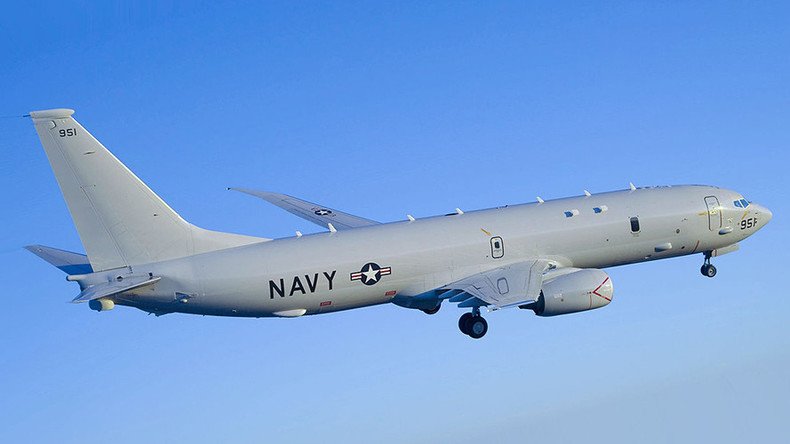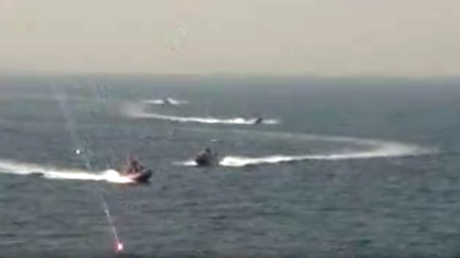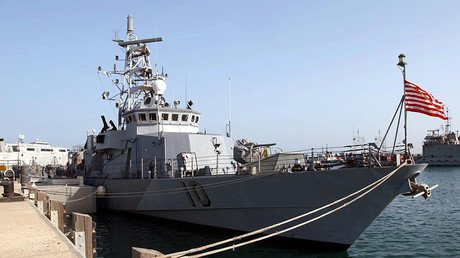US ‘tests’ Iran’s reaction to spy plane flyby, complains about ‘unprofessional’ shootdown warning

Two US spy planes have flown within a mile of Iranian airspace, and have received warnings of a potential shootdown should they breach it. US military officials said Iran behaved “unprofessionally” and “unsafe[ly]” during the stunt designed to “test” its reaction.
As confrontations between the two nations increase in the region, with Tehran allegedly threatening to shoot down US spy planes in the vicinity of its borders, the US navy also voiced the need to establish the rules of behavior between Iran and the US to avoid armed conflict.
A number of anonymous defense officials told Fox and CNN news that over the weekend the Iranian military warned the nine-member crew of the Navy Boeing P-8 Poseidon aircraft and a 24 member crew of EP-3 Aries not to enter Iranian airspace or they would run the risk getting shot down.
According to officials the September 10 warning was issued as both planes flew on a reconnaissance mission 13 miles off the coast of Iran, in the Strait of Hormuz and Gulf of Oman. That is just one mile short of the 12 nautical miles that belong to Iran’s territorial waters.
One US official told Fox News that American planes ignored the warning and continued on their mission, but without infringing on Iran’s air space.
“We wanted to test the Iranian reaction,” the US official told Fox. “Anytime you threaten to shoot someone down, it’s not considered professional.”
Other officials also called Tehran’s threat “unprofessional” and “unsafe” despite the Fox report which cited the latest intelligence assessment, that said that there were no Iranian missile launchers in the area.
Earlier this month Brigadier General Abdollah Reshadi told reporters that Iran’s Air Defense Force constantly monitors the skies nationwide to observe and detect hostile activity.
“[Our] radar coverage of the Persian Gulf and the Sea of Oman detects aerial traverse by [reconnaissance] aircraft,” Reshadi said. “We detect any flying activity in time and deliver tactical response in less than two minutes.”
The latest incident in the Persian Gulf comes as the US continues to insist that Iran is harassing its warships in the region. According to reports, there have been more than 30 close encounters with Iranian vessels by American ships so far this year. Just last week, US Navy ship changed course after Iran’s plane came within 100 yards (91 meters) of USS Firebolt in the central Gulf. That was at least the fourth reported encounter in less than a month.
On Sunday, Iran’s chief Armed Forces spokesman dismissed US claims of being harassed by the Iranian military, stressing that Iran’s actions are in line with international law.
“Vessels belonging to the Islamic Republic of Iran are fully aware of international laws and regulations and have always acted based on stipulated standards, so the [US] claims are not only fictitious, but stem from their fear of the might of the Islamic Republic of Iran’s forces,” said Deputy Chief of Staff of Iran's Armed Forces, Brigadier General Massoud Jazayeri.
To avoid further close encounters between the US and Iranian navy in the Gulf, US Admiral John Richardson, chief of naval operations, urged both nations to agree on rules of behavior.
“These are some of these potentially destabilizing things, where a tactical miscalculation, the closer you get to these sorts of things, the margin for error gets smaller and the human error can play a bigger and bigger role,” Richardson said. “So it’s very important that we eliminate this kind of activity where we can. There’s nothing good can come from it ... it also advocates the power of a sort of leader-to-leader dialogue.”
“Getting some kind of a rule set like that ... with the Iranians, would also be helpful, so that we can have these frameworks for behavior that would guide us more to the useful types of encounters at sea, rather than these 'close aboard' types of demonstrations that really don’t have any positive benefit,” the admiral added.
READ MORE: Iranian vessels mounted with machine guns approach US warship in Strait of Hormuz
The Strait of Hormuz is a key maritime route, through which about one-fifth of the world’s oil supply flows. Bilateral encounters in the region intensified after Iran detained 10 US sailors earlier this year as they entered Iranian waters near the Farsi Islands on two military boats. The US claimed the incident was due to mechanical failure, with Iran later releasing all of the US servicemen.














